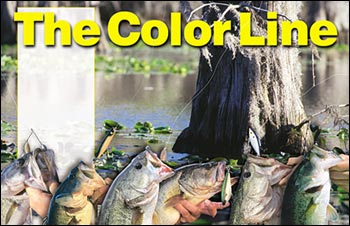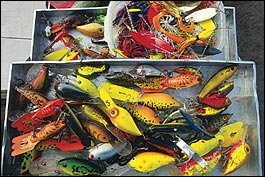
The real truth on how to go about selecting lure color
By Paul A. Cañada
Page 2
Water clarity and color
As Hughes' experience demonstrated, a change in water clarity often determines how effective a lure color is going to be. "I try to keep color selection real simple," explains Hughes. "The first thing I consider when selecting my lure color is the color of the water."
When visibility is better than 3 feet, Hughes fishes natural colors such as pumpkin, watermelon and other shades of green, or baitfish imitations such as silver, white and gray. In addition, when fishing soft plastic baits such as worms, grubs, tube baits and twitch baits Hughes prefers transparent versions of natural colors. "In clear water," Hughes reports, "the fish rely more on vision when locating their prey. Those transparent colors give the fish just a hint of color and a faint profile to look at. When water clarity is good, the fish often reject anything that doesn't look natural. That's why we downsize our line diameter and bait size in real clear water."
 When fishing a bottom-hugging or slow-moving bait, the Purtis Creek guide finds it's important to match the color fished with the color of the bass' environment. He argues that the coloration of most animals found in the freshwater environment(including the bass(typically matches the background of their environment. "Fish do this for protection," concludes Hughes; "it's a form of natural camouflage. That's why bass are typically a dark green in hydrilla-filled lakes and a pale color in clear, rocky impoundments." When fishing a bottom-hugging or slow-moving bait, the Purtis Creek guide finds it's important to match the color fished with the color of the bass' environment. He argues that the coloration of most animals found in the freshwater environment(including the bass(typically matches the background of their environment. "Fish do this for protection," concludes Hughes; "it's a form of natural camouflage. That's why bass are typically a dark green in hydrilla-filled lakes and a pale color in clear, rocky impoundments."
Hughes moves away from transparent colors and toward opaque colors as visibility decreases. In stained water, bass use their lateral line and hearing, along with vision, a bit more to find prey. Hughes finds the solid profile of an opaque color helps the bass find the bait in the colored water.
Still, the pro angler continues to copy nature by choosing a natural looking, dark-over-light color scheme. When fishing slow moving baits, Hughes typically fishes one of the popular two-toned colors such as red shad, gray shad and blue shad. He chooses similar color schemes when fishing crankbaits and spinnerbaits. Hughes argues the dark back and light bottom found on most creatures in the bass' freshwater environment acts as camouflage.
A special trick that Hughes often employs when fishing stained water is dipping the tail of a worm, feet of a lizard and skirt of a tube bait in a red or chartreuse dye. "I can't explain why the fish go after that chartreuse or red tail," he admits, "but I know they do. Those colors might give an illusion of added movement. When I really need to get the bass' attention I tip my baits with the colored dye."
Finally, in heavily stained to muddy water, Hughes fishes both dark and bright colored baits. When fishing a slow, bottom-bumping bait like a jig or worm, the guide goes with a black-, black/blue- or black/red-colored lure. However, when fishing a moving bait like a spinnerbait, crankbait or jerkbait, Hughes goes with a bright color like fluorescent orange, chartreuse or bubblegum. Although the bass' lateral line and hearing is used mostly to find prey in heavily stained water, the easily seen colors help the bass zero in on the lure.
The color of night
Surprisingly, anglers that spend a tremendous amount of energy and time on color selection during daylight hours often give color selection very little consideration during nighttime angling trips. According to Lake Whitney guide Ron Gardner, color selection can also make a big difference at night. Gardner finds that in addition to water clarity, light penetration plays an important role in nighttime color selection.
Of course, the nationally recognized smallmouth guide predominantly fishes popular nighttime colors such as black, blue and purple. However, the nighttime specialist has honed his color selection process to match the best color variation to the conditions at hand. Gardner and his clients' catch records(10 smallmouth over 7 pounds, nearly 800 over 6 pounds(testify to the effectiveness of his system.
Again, whether fishing at night or day, light penetration is a major consideration in the color selection process. Gardner finds four factors(water clarity, the amount of lunar light, cloud cover and wind(determine the amount of light that penetrates the bass' nighttime environment. For example, a windy or overcast night will cut the amount of lunar light penetrating the water.
Typically, Gardner fishes the traditional nighttime colors during periods of poor light penetration and lighter color combinations during periods of good light penetration. "During the first moon phase when light penetration is poor," Gardner says, "I have my best success with darker baits. I fish baits that are predominantly black, tipped with blue, purple and red."
During a 1/2- to 3/4-moon phase, Gardner switches to baits with a 50/50 color combination. Some of his favorite colors for this period are solid red, black/chartreuse, black/red and purple/red. "It's important to have a variety of colors available," advises Gardner, "especially during this period. Sometimes the fish are picky, preferring one color combination over another. I don't have a clue why this happens, but it does."
When the moon is full and light penetration the greatest, Gardner fishes lighter color combinations. Colors like solid red and blue, and combinations like purple/red, light brown/pink, purple/ chartreuse, bubblegum and other high contrast colors work well under a bright moon. Although Gardner primarily fishes spinnerbaits at night, he argues his color selection process works well for both soft plastics and crankbaits.
Both Gardner and Hughes place a great emphasis on keeping the process of color selection as simple as possible. Both anglers base their decisions on environmental conditions like water clarity and light penetration. Still, Hughes admits that confidence plays a major role in how well a color catches fish. "The bottom line is, you have to have confidence in the color you select," he concludes. "You're going to fish a bait more completely and with more purpose when you have confidence in it."
# # # #
page 1 / page 2
| 




